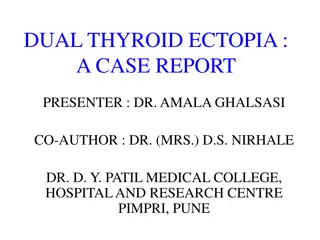Ectopic Ureter in Veterinary Medicine
Ectopic ureter is a condition where the ureter does not connect properly to the bladder, commonly seen in cats and dogs. This abnormality leads to urinary incontinence and can be treated through surgery and laser management via cystoscopy. Learn more about the causes, symptoms, and treatment options for ectopic ureter in animals.
Download Presentation

Please find below an Image/Link to download the presentation.
The content on the website is provided AS IS for your information and personal use only. It may not be sold, licensed, or shared on other websites without obtaining consent from the author.If you encounter any issues during the download, it is possible that the publisher has removed the file from their server.
You are allowed to download the files provided on this website for personal or commercial use, subject to the condition that they are used lawfully. All files are the property of their respective owners.
The content on the website is provided AS IS for your information and personal use only. It may not be sold, licensed, or shared on other websites without obtaining consent from the author.
E N D
Presentation Transcript
ECTOPIC URETER Dr. Mithilesh Kumar Assistant Professor cum Jr. Scientist Department Surgery and Radiology Bihar Veterinary College, Patna-800014
Urinary tract is made up of right and left kidney. Each connect with bladder through right and left ureter. Ureter does connect properly to bladder Drains outside the bladder the condition is called ectopic ureter. It is commonly a result of a duplicated renal collecting system. Duplex kidney with two ureter. One drains correctly, duplicated ureter presenting as ectopic
Ureter Connects the Kidney with urinary bladder. Ectopic ureter is abnormality of ureter. Ureter does not enter urinary bladder in correct anatomic position. Cats and dogs are affected by birth. Causes urinary incontinence Disruption in normal embryogenesis
Also called wet puppy syndrome Hereditary problem in golden retriever. Intermittent or continuous urinary incontinence since birth. Most dog dogs also display normal voiding of urine. Dog has had limited exposure to other dogs. Aggression is common symptoms
Surgery is the treatment in most cases. Also managed with lasers via cystoscopy,. Thin light tube inserted into bladder via urethra.
Puppy with ectopic ureters (both right and left). Contrast dye shows the kidneys and Puppy with ectopic ureters (both right and left). Contrast dye shows the kidneys and ureters. ureters. There is no contrast in the bladder indicating the urine bypasses the bladder. There is no contrast in the bladder indicating the urine bypasses the bladder.
Candidate for Candidate for Neoureterostomy Neoureterostomy
candidate for Neoureterocystostomy candidate for Neoureterocystostomy
The urachus is a fetal continuation of the bladder taking waste to the allantoic sac. It should be atrophy shortly after birth and disappear in normal calf The urachus is a fibrous remnant of allantois PU Observed in cow calves and also recorded in buffalo calves Urine dribbles from the umbilicus. In absence of treatment infection lead to abscess. Peritonitis and cystitis may develop
Urination from both the penis and the navel in a foal with a patent urachus.
Calf sedated deeply and controlled in dorsal recumbency. Incision given on umbilicus extended cranially and caudally. Umbilicus vessels and urachus are doubly ligated proximal to infection The infected mass is dissected out. Muscle are closed by overlapping sutures. Skin closed routinely.























